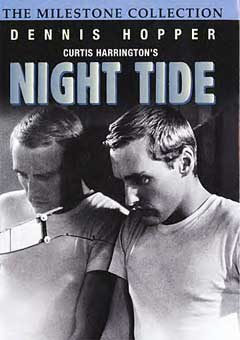 NIGHT
TIDE (1963)
NIGHT
TIDE (1963)Director: Curtis Harrington
Image Entertainment
 NIGHT
TIDE (1963)
NIGHT
TIDE (1963)NIGHT TIDE commences on the extraordinary aquatic setting of Santa Monica Pier as a young, trim sailor, John ("Johnny") Drake (Dennis Hopper, in one of his first roles ever) takes in the arcades as waves splash underneath and the sound of seagulls fills the air. Inserting a coin into a machine slot, he smiles as instant black and white photos are taken of his innocent countenance. He then visits the merry-go-round and is enraptured as any child ever would be.
Johnny then takes a stroll that
will change his life forever when he wanders into a Venice Beach bar called
The Blue Grotto. The club is filled with Fifties eccentrics, "beat"
poet types and artists. He nurses a beer and spots a local beauty with dark
hair, a girl named Mora (Linda Lawson). He is captivated with her and comes
over to join her at her table. Their conversation is interrupted as a thin blond
woman of noble demeanor approaches Mora speaking something very threatening
in Russian or another Slavic tongue (recalling the "cat-to-cat" encounter
in Val Lewton's classic CAT PEOPLE, a direct homage). Unnerved, Mora leaves
with Johnny follow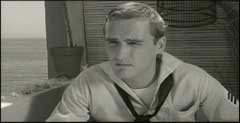 ing
her along the pier. He begs to see her again and her iciness melts somewhat
and she agrees to share lunch the next day.
ing
her along the pier. He begs to see her again and her iciness melts somewhat
and she agrees to share lunch the next day.
The following sunny afternoon Johnny has come back to see Mora. He is attracted by the merry-go-round on the pier and heads on up to visit her above the arcade in a spectacular seaside apartment. Mora has prepared a seafood lunch and the two begin to converse about their lives. She then makes a startling admission to Johnny: she not only admits to being an "attraction" but a REAL mermaid at that!
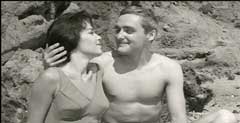 Mora
has a history of destroying former boyfriends which is brought to Johnny's attention
by her guardian (it is only hinted at by him) but more directly and candidly
by the character portrayed by Luana Anders, who seems genuinely interested in
the boy's welfare. Is Johnny in danger of becoming Mora's next victim? A fortune-teller
does his Tarot reading and when the card meant to represent Johnny is The Hanged
Man, the answer seems to point to a definite YES!
Mora
has a history of destroying former boyfriends which is brought to Johnny's attention
by her guardian (it is only hinted at by him) but more directly and candidly
by the character portrayed by Luana Anders, who seems genuinely interested in
the boy's welfare. Is Johnny in danger of becoming Mora's next victim? A fortune-teller
does his Tarot reading and when the card meant to represent Johnny is The Hanged
Man, the answer seems to point to a definite YES!
Director Curtis Harrington had been a formidable talent in early American avant garde cinema and his numerous forays in experimental film are testament to his genius. Born in Banning, California [a mere 13 miles or so from Palm Springs] Harrington dreamt of coming to Hollywood and becoming a filmmaker himself. He distinguished himself with a number of short films (i.e. "Fragment of Seeking," "The Assignation" and others) which were ghostly mood pieces he shall always be remembered for. His European travels included living in Paris as a youth, and his close personal friendship with James Whale is the stuff of dreams.
Dennis Hopper gives an outstanding
performance as the innocent, lovesick sailor on leave in one of his earliest
film roles. Hopper had shown great promise and this entry in his filmography
is one of the key moments in his career. He had jut finished a part in GIANT
and was well on his way to stardom. He brought his training in method acting
to the proceedings and even helped Harrington understand better this school
of thought. Hopper is endearing in his role and one feels empathy for his plight.
Hopper 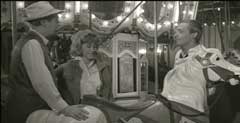 would
go on to key roles in EASY RIDER (1969) and David Lynch's masterful BLUE VELVET
(1986). He continues to collect and appreciate fine art and has appeared in
a number of documentaries devoted to that subject.
would
go on to key roles in EASY RIDER (1969) and David Lynch's masterful BLUE VELVET
(1986). He continues to collect and appreciate fine art and has appeared in
a number of documentaries devoted to that subject.
Linda Lawson recalled great difficulty in dealing with the ever-erratic behavior of Dennis Hopper. One afternoon he arrived at her apartment to rehearse and instead of working, behaved like a spoiled child and crawled under her kitchen table and clowned around to the point that she had to ask him to leave. Her relationship with Hopper soured after that and she felt that his talent was going to be jeopardized by his addictions. Her film career was brief and the actress retired after marriage to a Hollywood producer.
Chicago-born and British educated
character actor Gavin Muir gives the final performance of his career as the
owner of Mora the Mermaid's arcade and in fact, the man responsible for bringing
her back during his seafaring days from the Greek isle of Mykonos, 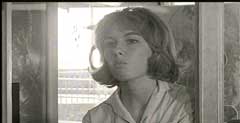 in
effect the mermaid's guardian. Muir had appeared in such films as SON OF DR.
JEKYLL (1951), ABBOTT AND COSTELLO MEET THE INVISIBLE MAN (1951) as well as
two key, classic Universal Pictures features with Basil Rathbone during the
Forties, SHERLOCK HOLMES FACES DEATH (1943) and SHERLOCK HOLMES IN WASHINGTON
(1943). He retired after NIGHT TIDE and passed away in 1972.
in
effect the mermaid's guardian. Muir had appeared in such films as SON OF DR.
JEKYLL (1951), ABBOTT AND COSTELLO MEET THE INVISIBLE MAN (1951) as well as
two key, classic Universal Pictures features with Basil Rathbone during the
Forties, SHERLOCK HOLMES FACES DEATH (1943) and SHERLOCK HOLMES IN WASHINGTON
(1943). He retired after NIGHT TIDE and passed away in 1972.
Luana Anders gives a very sympathetic
performance in a small role and remained a close friend of Harrington for the
rest of her life which was cut short by cancer. She would go on to work that
same year with Roger Corman, Vincent Price and Barbara Steele in the celebrated
PIT AND THE PENDULUM (1961), easily along with MASQUE OF THE RED DEATH (1964)
and TOMB OF LIGEIA (1965), some of the finest moments for American-International
Pictures.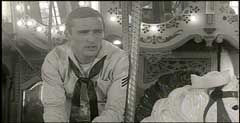
There is also an amazing audio commentary with Director Curtis Harrington and Dennis Hopper. When Hopper is fuzzy on some detail, Harrington fills in with the information. Some interesting facts are brought forth: that the film cost a mere $28,000 to make (Harrington insists $50,000) but it was notably a non-studio, renegade production. Harrington donated a copy early on to Henri Langois of the Cinematheque Francaise. Both men were impressed with Raksin's musical score. The customers in The Blue Grotto café (shot in Hollywood on Cahuenga Street and not at a beach) were also friends and not actors. Both recall warmly Linda Lawson (who saw it again only recently and quipped how thin she was at the time), and Luana Anders is fondly remembered as a fine actress who should have gone on to larger roles as both men had enormous faith in her. Curtis notes his inspiration for the script was a short story titled by "Secrets of the Sea." Also, the Gavin Muir part was to have gone to Peter Lorre but his fee was too high for Harrington. There is more to report but one should purchase the disc and enjoy every aspect of NIGHT TIDE!
The original score for NIGHT TIDE
was the work of composer David Raksin, whose credits included such diverse fare
as the 50s gangster bio AL CAPONE (1959) with Rod Steiger, the essential noir
masterpiece FORCE OF EVIL (1948) with John Garfield and 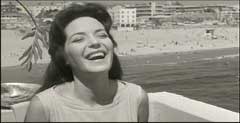 genre
pieces such as 20 MILLION MILES TO EARTH (1957) and THE UNDYING MONSTER (1942).
He would team with Harrington once again for his WHAT'S THE MATTER WITH HELEN?
(1971). His work in NIGHT TIDE is stellar, replete with wind instruments combined
with Fifties Beat Generation touches. One clever little piece is "The Tell-Tale
Harp" which is played in The Blue Grotto at the film's beginning, Harrington's
homage to Poe via Raksin.
genre
pieces such as 20 MILLION MILES TO EARTH (1957) and THE UNDYING MONSTER (1942).
He would team with Harrington once again for his WHAT'S THE MATTER WITH HELEN?
(1971). His work in NIGHT TIDE is stellar, replete with wind instruments combined
with Fifties Beat Generation touches. One clever little piece is "The Tell-Tale
Harp" which is played in The Blue Grotto at the film's beginning, Harrington's
homage to Poe via Raksin.
The source print for NIGHT TIDE is flawless and pristine; it is preserved for posterity in its 1.85:1 aspect ratio. The sterling black and white photography by Vilis Lapenieks and an uncredited Floyd Crosby (who had studied under Murnau and was the father of David Crosby of Crosby, Stills, Nash & Young!) is outstanding and dream-like, reminiscent of the best of Cocteau with the timeless, ancient, mythic beauty of Greek tragedy. NIGHT TIDE contains 14 chapter stops and is 85 minutes in duration. The theatrical trailer is included in this presentation. (Christopher Dietrich)